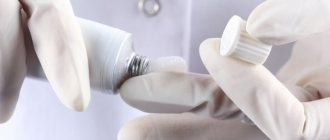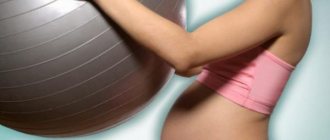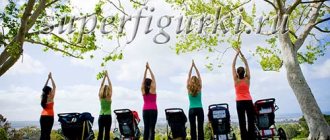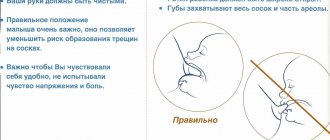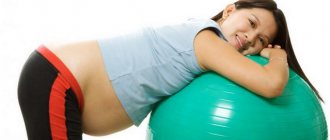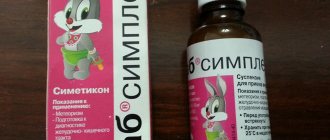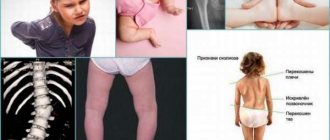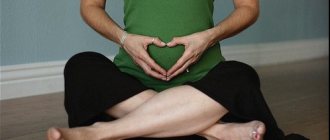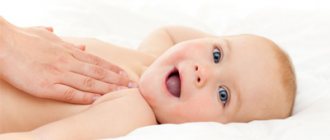Being a young mother is an unforgettable experience; it brings many new emotions and impressions. Constantly being alone with the baby and following a daily routine can be difficult psychologically and physically for a new mother, but thanks to modern technology, life with a newborn is quite easy to arrange. Just a few weeks after giving birth, more and more young girls are trying to find time for themselves. Exercises with a child in your arms are an excellent way to maintain a good appearance and a cheerful mood.
Choosing a class time
It is recommended to start doing the simplest exercises aimed at training the pelvic floor muscles, or Kegel exercises, already in the maternity hospital. Squeezing and unclenching the internal muscles of the vagina helps prevent problems with urination and restores the muscles of the uterus, stretched after pregnancy and childbirth.
sports exercises for a mother with an infant no earlier than 6-8 weeks after birth, if they passed without pathology. In case of cesarean section, heavy bleeding or other complications, it is better to postpone gymnastics until you consult a gynecologist or your doctor.
Fitness exercises should be carried out provided that both mother and baby are in good health. Her goal is not only to restore the female figure after childbirth, but also to enjoy the time spent with the baby.
The best time to play sports with a baby in your arms is the period from 3 to 12 months of the baby . A baby at this age is already strong enough for a little joint gymnastics. It can serve as a weight for exercises with loads and at the same time it does not move too confidently and can be fixed in the position that is required.
You should not deal with the baby immediately after feeding, so as not to cause regurgitation; it is better to wait 40-45 minutes.
Naturally, the baby should be active and alert while charging. If the baby is naughty or falls asleep, you will have to choose a different time for training or wait until he sleeps and do the exercises yourself.
Gymnastics for mother and baby - video:
Joint gymnastics between mother and child is not only the health of the baby, but also another reason for communication between the closest people in the world. This is not a labor-intensive workout, but simple exercises that do not cause fatigue in the mother, and give the baby only positive emotions. In children under the age of one year, physical development keeps pace with psychological and mental development, so a little time spent at an early age is a huge investment in the baby’s future. But the most amazing thing is that there are exercises in which both the child and the mother train at the same time.
Fitness rules for mothers with children
Carrying out home sports activities for mothers and babies requires following simple rules:
- The mother's movements should be soft and smooth, so as not to scare or harm the baby.
- It is forbidden to run and jump with a child in your arms due to the high load on the baby’s spine when shaking.
- The child must be supported and secured to prevent him from falling during training (babies up to 3-4 months should be supported by the head, then held by the arms).
- If the baby cries, home exercises should be completed and calmed down.
- You should start with a minimum number of approaches, gradually increasing the load.
- Physical training should bring joy and satisfaction, not fatigue.
Exercises up to six months
A child several months old is very flexible, it is easy and interesting to work with him, but he is also fragile, so you need to work with him carefully. In the usual case, ten repetitions of each movement are enough, but the number of exercises in one approach can be increased over time to 20 times. It is advisable to exercise for up to 20 minutes; there is no point in doing this anymore, since the child still has a feeding and sleeping schedule. Also observe hourly intervals between quiet time, meals and exercise. The exercises are intended for mothers who understand that maternity leave is not a burden, but a time of new opportunities. Simple exercises:
Exercises with a child in your arms
You should start your fitness classes with a warm-up in the form of a quick step or jumping in place, dancing to your favorite music. It is better to carry out this part of the training without the child, leaving him in a crib or other safe place (on the floor, in the playpen). After 4-5 months, the baby will follow with interest the actions of the mother, which will benefit the development of his attention and observation.
You can turn on the music and dance with your child, moving smoothly and calmly.
Fitness for mothers with babies includes exercises for various muscle groups, but the main focus is on the abs, abdomen, and buttocks as the areas most affected during pregnancy. You should also not forget about back exercises, since carrying a baby in your arms for a long time puts a serious strain on the spine.
Initially, any exercise is performed with a minimum number of approaches. The increase in load should be gradual and not lead to overwork. In case of discomfort or pain, especially in the lower abdomen, exercise should be stopped.
Abdominal exercises
Abdominal exercises can be performed no earlier than 2-3 months after the baby is born. If there are surgical scars, the date for starting classes is recommended by the doctor; violating it is dangerous due to the risk of sutures coming apart.
- Starting position: lying on your back, legs bent at the knees, the child lies on the mother’s stomach or sits, leaning on his hips as if on the back of a chair. Mom raises her head, lifting her shoulder blades and shoulders off the floor, and tries to reach her knees. This is a classic abdominal exercise with the only difference being that there is a baby on the woman’s body.
- Lying on your back, bend your knees and press them to your chest. Place the child on his shins parallel to the floor. In this position, try to lift your head and shoulders off the floor, straining your buttocks, folding even more.
Exercises for the buttocks and thighs
- Squat with the baby on your neck or in a sling.
- Rock the baby on your shin, sitting in a “leg to leg” position, while at the same time you can recite a nursery rhyme or a nursery rhyme.
- Lie on your back, bend your knees 90 degrees and place your feet on a sofa or low chair. Place the baby on your stomach, holding it, lift your buttocks, stretching your body in one line. Hold the position for 3 seconds and, relaxing, lower to the floor.
- Lunges with a child in your arms. Alternately stand on the knee of your right and left legs, holding the baby upright, tightly pressed to you.
Exercises for new mothers after cesarean section: when to start
During the period of bearing a child, the mother's figure changes significantly. Even if a woman’s weight returns to normal after childbirth, stretch marks and a sagging tummy remain on her body. New mothers strive to regain the former beauty and grace of their body.
If the baby was born through surgery, the woman should remember that physical activity is strictly prohibited for a month or two.
Sports exercises, especially on the abs, can damage the sutures and cause bleeding.
Light morning exercises and special exercises for contracting the uterus can be performed 7 days after birth, if there is no pain. You can start gentle exercises 2 months after cesarean section. In this case, you need to start with minimal loads, gradually increasing them. If after training you feel unwell or experience pain, it is recommended to stop any exercise.
Full-fledged sports for nursing mothers are allowed only after six months, when the woman’s body has fully recovered after the operation. At first, it is advisable to work with a trainer who will help you choose the right program and intensity of training.
Fitness for moms in the pool and gym
You can train with your baby both at home and in a special room.
Many fitness centers offer similar services for mothers with children over 3 months old . Classes in the gym are conducted under the guidance of an experienced trainer and include a full range of exercises for losing weight and restoring the body after pregnancy. Postpartum gymnastics has a beneficial effect on a woman’s health and gives her vitality.
Attending such classes is a great way to get in shape, be physically active, make new friends and expand your social circle.
A popular type of physical activity with a baby is baby yoga. This is a set of asanas selected for women after childbirth and performed together with their babies. The older children are, the more actively they become involved in yoga practice. During training, mainly static poses are used, which alternate with rest. This activity will not only put your body in order, but will also teach you how to properly relax and distract yourself from the hustle and bustle of everyday life.
A significant disadvantage of training in a specialized center is the need to visit a public space at a certain time. In young children, their immunity is still developing and they can easily be susceptible to viruses. In addition, the periods of sleep and wakefulness of babies up to 3-4 months are just being established, so it may be difficult to synchronize training and daily routine. It is also important that the road to the center is not tiring for either mother or baby.
An alternative to fitness can be swimming. Special classes for mothers with babies are held in many swimming pools. Many children under one year old enjoy swimming and can easily learn to dive if they regularly attend classes. Staying in cool water helps strengthen the immune system, strengthening, physical development and restful sleep of the baby after training. When choosing a pool, you should pay attention to the quality and method of water purification, the availability of conditions for babies (changing tables, playpens). Classes must be taught by a certified instructor.
Contraindications
Relative contraindications to gymnastic exercises for newborns are congenital heart defects, hemangioma, as well as the presence of a large umbilical or inguinal hernia. Sometimes doctors recommend refraining from gymnastic exercises in case of certain congenital diseases of the joints and musculoskeletal system, for example, when the hip joints are immature, special, therapeutic gymnastics should be done and only when the baby grows up a little.
Gymnastics is not done if the child has vomiting, diarrhea, or fever.
Be sure to tell your pediatrician about the possibility of classes - he will visit you the very next day after discharge from the maternity hospital. For the vast majority of children, doctors allow such activities, and with pleasure: a mother’s desire to develop her child is always commendable.
Lessons on the street
In the warm season, you can do gymnastics while walking while the baby sleeps in a stroller . At the first stage, it is enough to alternate fast and slow walking paces, roll from toe to heel, walk on tiptoes and goose step. You can practice leg swings, try to do “swallows” and squats, if your physical fitness allows.
Don't forget about your hands. Although carrying a child in your arms in itself stimulates the development of the muscles of the shoulder girdle, it is worth adding unloading exercises: rotating your arms in a circle, squeezing your clasped hands while holding your elbows at chest level. The last task also helps prevent milk stagnation during breastfeeding.
Some models of strollers allow you to go for a full run when walking with your baby. For such training, you need to choose smooth paths away from highways in order to minimize the child’s shaking. You should pay attention to the stability of the stroller when turning.
At the dacha or in your own home, you can do all the same exercises as at home, while being outside, combining the benefits of physical activity with being in the fresh air.
Development of a child’s hand from 2 months to 1 year
Development of movements of a child’s fingers and hand as one of the methods of speech development Development of a child’s hand from 2 months to 1 year
The origins of children's abilities and talents are at the fingertips of V. A. Sukhomlinsky The movements of a child's fingers and hands have a special developmental effect. The influence of manual (manual) influences on the development of the human brain was known back in the 2nd century BC. In China, experts claim that games involving hands bring the body and mind into a harmonious relationship and keep the brain systems in excellent condition. In China, palm exercises with stone and metal balls are common. In Japan, walnut palm exercises are widely used. Research by Russian physiologists confirms the connection between the hand and brain development. The works of V. M. Bekhterev proved the influence of hand manipulations on the functions of higher nervous activity and speech development. Simple hand movements help remove tension not only from the hands themselves, but also from the lips, and relieve mental fatigue. They are able to improve the pronunciation of sounds, and therefore develop the child’s speech. Research by M. M. Koltsova has proven that each finger has a representation in the cerebral cortex. She notes that there is every reason to consider the hand as an organ of speech - as well as an articulatory apparatus. From this point of view, the projection of the hand is another speech zone. The development of fine movements of the fingers precedes the appearance of syllable articulation. Thanks to the development of fingers, a projection of the “scheme of the human body” is formed in the brain, and speech reactions are directly dependent on the training of the fingers. Such training should begin from a very early age, because in an infant in the very early stages of life, motor skills are the first and only aspect of development that is accessible to objective observation. Normal development of motor skills indicates normal development of the child. Specialists from the Institute named after. G.I. Turner recommends starting work on the development of a motorboat from 2 months. At this age they recommend the following exercises:
- pull on the baby's fingers as if you want to pull them out; movements should be very light and gentle;
- Make circular movements with each finger separately, first in one direction and then in the other direction. It is also very good to use mini exercise machines. As such simulators, you can use “furry” latex balls (they are sold in pet stores). Until three months, place small balls with a diameter of 3-4 cm in the baby’s palms. When a child falls asleep squeezing these balls, his hands retain the correct shape. At 4-5 months, we use large balls for massage. The massage also changes: holding the child’s hands in yours, you need to hold the ball between his palms and twist it. At 5-6 months, to strengthen the muscles of the palms, it is good to use the “Combing” exercise: we lift the baby’s hands up one by one and smoothly move them along the head forward and back. When performing this exercise, the muscles of the shoulder girdle, palms, and fingers work. At the same age, we move on to hand massage, massaging each finger, each phalanx. We knead daily for 2-3 minutes. At 6-7 months, we add rolling a walnut over the child’s palm (circular movements) for 3-4 minutes to the previously performed exercises. At 8-10 months, we begin to carry out active exercises for the fingers, involving more fingers in the movement, and carry out exercises with good amplitude. The well-known exercises created by the talent of our folk pedagogy are good for training the movements of the fingers: “Ladushki”, “The White-sided Magpie”, “The Horned Goat”. At this age, I recommend using squeaky toys when doing exercises. Exercise “Duckling” Give the child a squeaky toy. When an adult pronounces the text, the child squeezes and unclenches the toy duckling clutched in his hand. You, duckling, are not eating, Better look for your mother. For this exercise, you can use other toys (kitten, chicken), changing the text of the poem. Exercise “Pussy” The child, first with one hand and then with the other, makes relaxing movements that imitate stroking movements. Pussy, pussy, pussy! – I called the kitten... (your child’s name) Don’t rush home, wait! – And stroked it with her hand.
At 10-12 months, invite your child to disassemble and reassemble the pyramid without taking into account the size of the rings. At this age, begin to teach your child to hold a spoon, cup, pencil. Start learning to draw “doodles”.
The main stages of development of motor skills of the hand
Gymnastics for newborns - what is it, how to do it correctly? Parents should know the basic exercises for their baby, because the sooner you start practicing, the more harmonious the development will be.
The benefits of exercising with a baby
Fitness with a baby in your arms will bring obvious benefits to both mother and baby .
Mom will be able to improve her appearance and mood. Restoring your figure will add self-confidence. Physical activity, especially outdoors, will give you energy and maintain vitality.
The child will receive new impressions and a wonderful experience of emotional interaction with his mother. Exercises with the baby as a weighting agent contribute to the development of his vestibular system and sense of balance. Children older than six months will try to repeat the movements, which will have a beneficial effect on the development of motor skills and abilities.
Fitness mom is a modern trend among young people; now it is fashionable to be beautiful and confident. Exercising and regular exercise will allow you to quickly and painlessly return to your pre-pregnancy form and give you strength and energy. You can do exercises both at home and outside, or attend sports classes for mothers with children in a fitness center or swimming pool.
Up to one year of age
The following exercises are for a child who can sit, he will soon learn to stand. Accordingly, mom can make more complex movements:
Gymnastics for young mothers who want to exercise with their child should be safe and enjoyable. You can do a specific set of exercises, or you can come up with your own movements that can be performed to music. The main thing is that in order not to injure the child, there is no need to make sudden movements, jumps, or shake the baby. But you can rock the baby smoothly; such static, unhurried movements will have a beneficial effect on the child’s well-being and on the mother’s muscles.
Every woman wants to get in shape faster after carrying a baby. Excess weight, stretch marks, sagging skin and other imperfections – you can begin to fight these “enemies” a short time after giving birth. You can combine sports with playing with your child, this will only bring mother and baby closer.
Let's stroke your face
Grab your baby's hands at the elbows and bring them together. In this case, your hands should completely cover the child's elbow joints, and your thumbs should be located on the inner surface of the child's forearms. Use your middle and index fingers to support the outside of your baby's forearm, with your fingertips on the back of the forearm.
Lift your child's hand and run it over his face. At the same time, the cam opens, and if you press on the back of the hand with your fingertips, this will happen faster. The palms must be directed towards the child's face. If your child constantly turns his hands inward, turning only the back of his hand toward his face, show him to your pediatrician
.
How to do gymnastics for a newborn?
Parents definitely want to know what principles to use when doing exercises. The main thing is that everything goes smoothly and without coercion.
Gymnastics for newborns up to a month is carried out very carefully. Do not shake, slam or jerk the baby sharply.
From a very young age, gymnastics turns into a game. Movements should correspond to natural ones as much as possible (as when crawling, when walking), muscle groups and joints are involved in the work.
Basic Rules:
- if there are no contraindications, it is advisable to start gymnastics from the 2nd week;
- The surface is prepared smooth and comfortable. A changing table or a moderately hard bed is ideal;
- Gymnastics and massage for newborns becomes part of the daily routine and should be done daily. At the same time - preferably;
- movements are performed calmly, effortlessly, from the limbs (periphery) to the center;
- When massaging the back, any impact on the spinal column is excluded. You should also avoid pressing on the area of the kidneys and heart;
- 3-5 repetitions of one exercise are enough, the total duration of gymnastics is no longer than 10 minutes;
- Charging should be done in a ventilated but warm room. It is better to practice when the child is naked, without diapers; in the summer you can do it outside;
- the load must be distributed between different muscle groups so that one-sided development does not occur;
- before exercise, a warming massage is good to prepare for upcoming exercises;
- If the baby is capricious and doesn’t like something, then it is better to postpone the exercise to a suitable time.
Exercises on an empty stomach are not recommended, as well as immediately after a meal; it is optimal when the child is still full and not yet hungry. If there are diseases and contraindications, then you just need to stroke the baby and pick him up more often so that he feels warmth and care.
